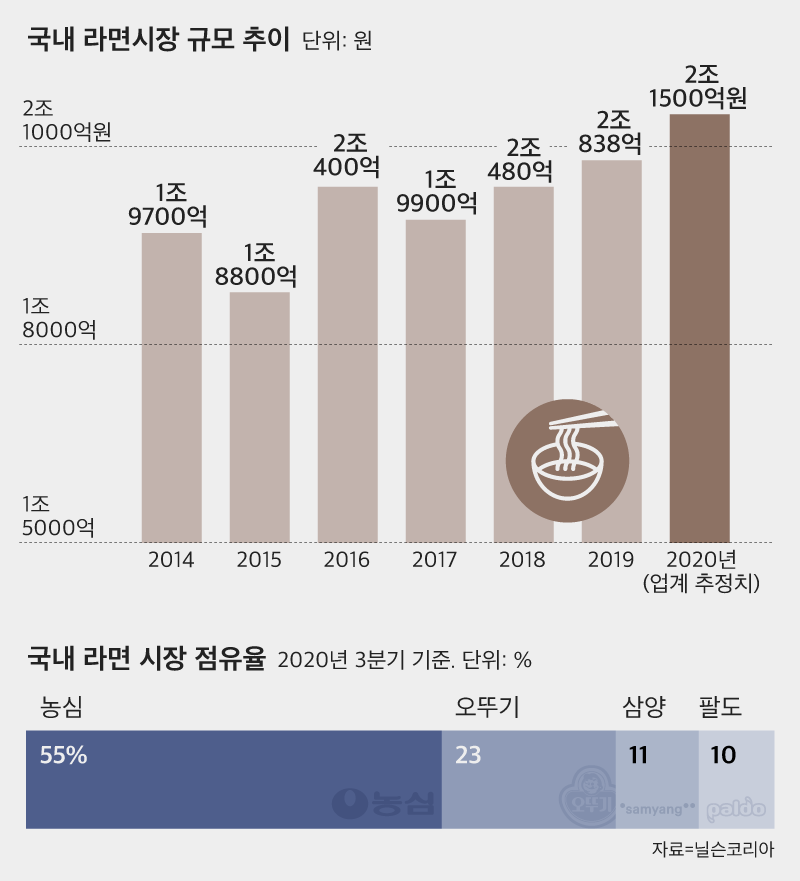Enter 2021.01.20 11:30
K-ramen is also popular…the domestic and overseas ramen market scales up to 3 trillion won
Harim’s Challenge to Nongshim and Ottogi Ramen Market
The domestic ramen industry is competing more intensely than ever. This is because the ramen market has grown rapidly as the demand for stockpile food has increased due to the coronavirus infection (Corona 19).
The domestic ramen market, which first exceeded the 2 trillion won mark in 2013, has since fallen into a serious stagnation. Sales, which had fallen to 1.99 trillion won in 2017, recovered to 2.475 trillion won in 2018, and then stepped in place.

According to the Ministry of Agriculture, Food and Rural Affairs on the 20th, domestic ramen exports increased 29% year-on-year, exceeding $600 million (720 billion won) for the first time ever. Considering the quantity of food companies produce directly at overseas factories, the amount of Korean ramen consumed overseas is estimated to exceed 1 trillion won.
The ramen market has been divided between Nongshim and Ottogi. According to Nielsen Korea, Nongshim occupies 55% of the ramen market (as of the third quarter of last year). Ottogi is second with 23%. Samyang (11%) and Paldo (10%) are following. Pulmuone recently released a series of’front, hongmyeon, and white noodles’, but consumer reactions are cold.
Harim, who was a meat processing company, threw a challenge here. Harim recruited a large number of retired executives from the ramen industry and received ramen know-how.
Harim has a long history in the poultry and poultry industry, and has a competitive edge in the HMR field using chicken, but other items have not. This is the reason why Harim claimed to be a general food company, but was evaluated as having a poor food portfolio.
The overseas expansion was also not active. Once ramen gains popularity, it is pointed out that its attractiveness is that it can generate steady sales and advance into overseas markets. Like Samyang Food’s Buldak-bokkeummyeon, a well-made ramen can be a good product to save businesses.
Harim plans to produce ramen at Harim Food Complex, which was built by investing 520 billion won in Iksan, Jeollabuk-do. The plant was completed at the end of last year. The new product name is’Soon Ramyun’.
Experts predict that if Harim introduces differentiated products based on the success story of Samyang Food’s’Buldak Stir-fried noodles’, it will be able to receive positive responses from consumers. In addition, the ramen manufacturing process is standardized, so it is not difficult to invest in facilities.
Launched in April 2012, Buldak Stir-Fried Noodles has since launched a number of variations, making’Buldak’ a brand. Samyang Food’s cumulative overseas sales exceeded domestic sales (211.1 billion won) at 286.4 billion won (as of the third quarter of last year).
However, the fact that the ramen industry has a thick entry barrier is an obstacle for Harim. With Nongshim, Ottogi, and Samyang being recognized for their competitiveness in overseas markets, it is unclear whether new business owners will be able to secure customers.
Because of this particularity, CJ CheilJedang, the No. 1 food company in Korea, and Daesang, the No. 2 food company, are not easily able to enter the ramen business. An official in the food industry said, “The core of food is taste in the end, and new business owners have no choice but to lack information on the taste that customers prefer.”
